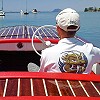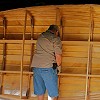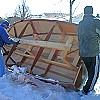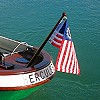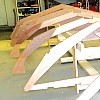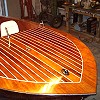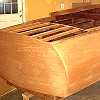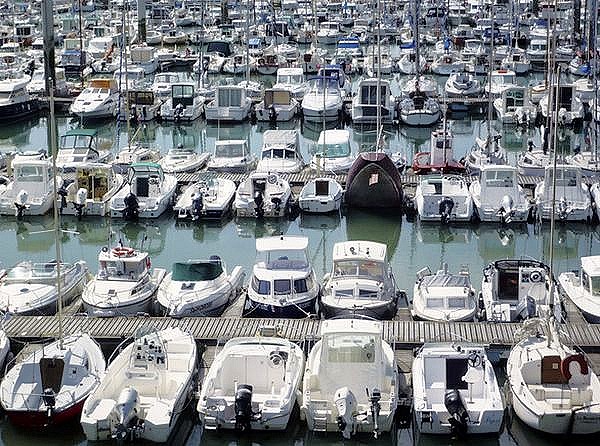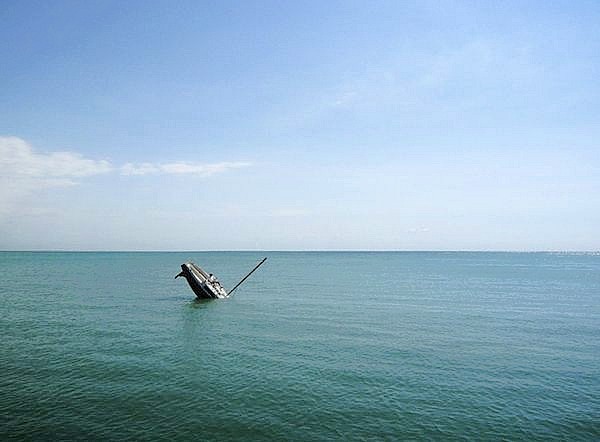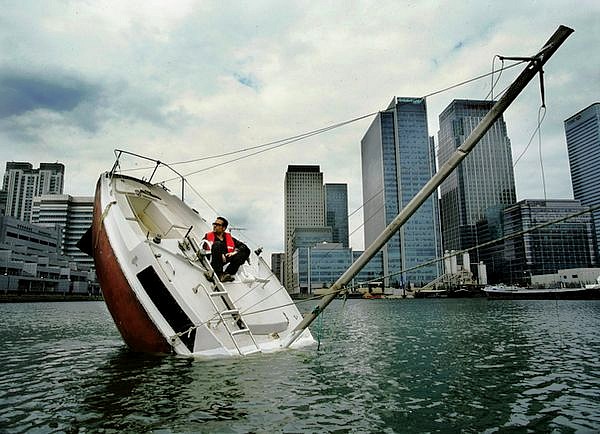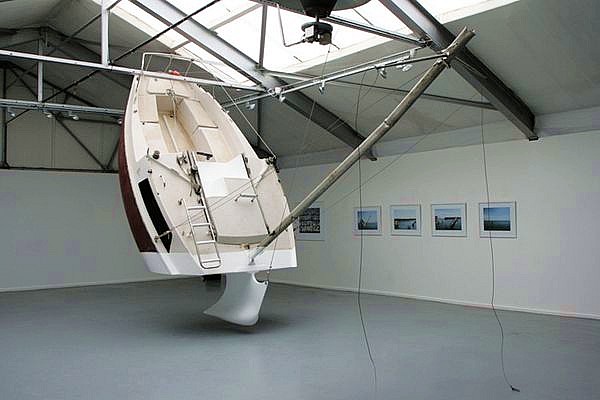

A place to share YOUR boat building story
Glen-L Marine Designs - 9152 Rosecrans Ave. - Bellflower, CA 90706
 In this issue
In this issue
-
What Made You Do It? by Alan
Close
-
Glen-L Boatbuilder of the
Month
-
I Fell in Love by Welton
Rotz
-
Designer's Notebook: Carvel
Planking
-
In Memoriam for Mrs.
ArtDeco
-
Photos posted since the last
WebLetter...
-
Recent email
-
Do You Need Attention,
Baby?
GLEN-L Update
Our heartiest congratulations to Darla Schooler
for 30 years of dedicated service to Glen-L.
Darla is an incredible storehouse of knowledge of all things
Glen-L,
and is one of the friendly voices you hear on the other end
of
the telephone when you call in to us.
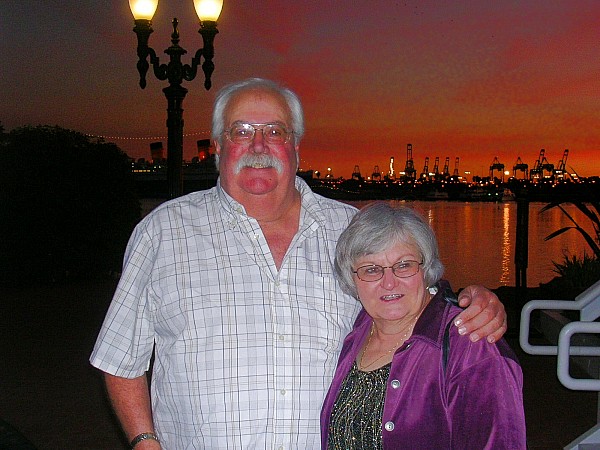
Next time you call, write, or email Glen-L be sure to say
hello to Darla
and thank her for being such a wonderful asset to all
of your and our boatbuilding ventures.
Learn more about
Darla in Gayle's blog post here.
Until next month . . .
Editor
What Made You Do It?
by Alan Close
"Have a look and you will understand...."
My name is Alan Close and I live in
Logan, (halfway between Brisbane and the Gold Coast)
Queensland, Australia. I originally bought the Monaco plans in 1997 but only started the
build in May 2008.
"What made you do it?"
I have been asked that question quite a few times,
"What made you want to build a mahogany boat"? Like
a lot of other builders I like old machinery, the
sound/sight/smell of a steam locomotive snorting at a siding,
the rhythmical beat of a radial engine at idle or the
beautiful flowing curves of a 1950's Alfa Romeo. So it
was only natural I wanted my own little piece of
nostalgia.
Although in many ways this appreciation may have compounded
my interest to build that classic speedboat, there is one
thing in particular that I believe is the real reason.
In the 1950's when I was about 7 or 8 years of age I was
given a kit boat. My father and I assembled and painted this
battery powered boat and I have kept it to this day. Have a
look at the photo of this boat and you will understand what
made me do it.
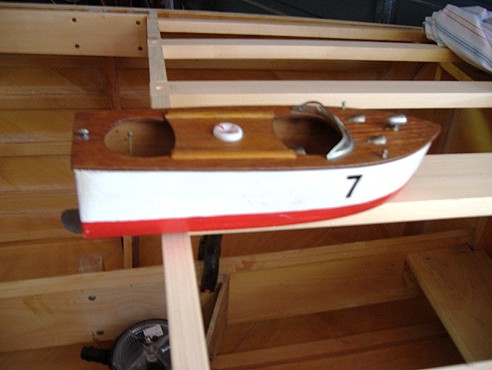
Thank you Glen-L for making dreams come true.
Editor's Note: See Alan's Monaco construction photos in Customer Photos
Glen-L Boatbuilder of the Month
Chris Atwood - Zip
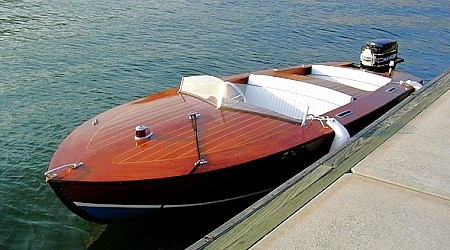 After building radio controlled airplanes
and boats for several years I really had the itch to build
something "full-scale". So with the encouragement
of friends and permission from my new bride, whose only rule
was I had to get her car in the garage each night, I ordered
the plans in April 2009. I decided on the "Zip"
because it would fit in half our 20x20 garage and it had room
for 2 adults and 2 kids, so it would be useful when/if we
have kids. I also wanted an outboard powered boat to keep
cost and complexity to a minimum.
After building radio controlled airplanes
and boats for several years I really had the itch to build
something "full-scale". So with the encouragement
of friends and permission from my new bride, whose only rule
was I had to get her car in the garage each night, I ordered
the plans in April 2009. I decided on the "Zip"
because it would fit in half our 20x20 garage and it had room
for 2 adults and 2 kids, so it would be useful when/if we
have kids. I also wanted an outboard powered boat to keep
cost and complexity to a minimum.
I was able to build the Zip with just basic tools. When I
started I was 27 years old, had just moved into my own house
and owned only basic hand-tools and a cordless drill. I
ordered the Zip plans, bought a sabre saw, a combination
bench-top belt/disc sander and a sheet of ¾ AB grade
marine plywood then started tracing the patterns to the wood.
In the first picture you can see I started working on the
garage floor, I didn't even have sawhorses at that point.
It took about 40 hours to build the entire framework and
assemble that onto the building form. At this point the
neighbors figured out what the contraption in my garage was
supposed to be.
Later on I bought a hand planer, a power planer, a handheld
belt sander, chisels, a second cordless drill, some specialty
drill bits, a hole-saw set and lots and lots of clamps. But
that's about all you really need, a router will also save
lots of time. Point is you don't need a wood working shop
or any experience outside of high school wood shop class to
build a really nice Glen-L boat.
I Fell in Love
by Welton Rotz
I fell in love with the Glen-L Tubby Tug design, bought the plans and
spent a year dreaming.
I studied all the archive photos; picking up an idea here,
springboarding off an idea there, looking at color layouts,
etc. Thanks to all of you who have helped in the creative
process. Anyone who likes some of my ideas is welcome to use
them. Glen-L designs are great in allowing for individual
creativity.
I knew I wanted to build a fantail on the tug, so I build
some small cardboard models to see how to bend the curves at
the stern. Then Bill Hodgdon's photos of his fantail
appeared and I knew it was possible to build a fantail.
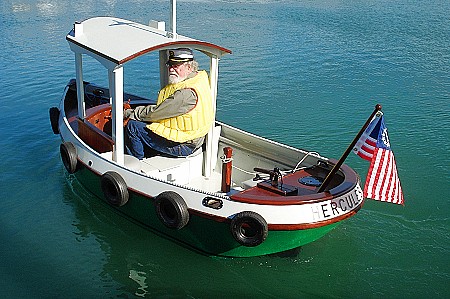 Bill lofted
the curves, which of course is the correct way to do it in
boat building. But lofting is not my strong suit, so I did it
another way. I built the hull including the transom. At the
butt joint of the forward and aft sections of the hull, I
joined the aft section of the hull to the butt block with
screws so I could remove it later. I mounted a 2 ft. X 4 ft.
sheet of 3/4 ply to the back side and top of the transom. I
drew the curve of the fantail on this sheet, being careful to
follow the lines of the hull as they came aft. I also blocked
up the sheet of plywood to follow the slight rise of the
horizontal line of the hull as the line moved aft. After
cutting this curve, I cut out an inner curve leaving about 3
inches of material. The result is an open "U". Save
the inner cut-out! The flat edge of this cut-out should be
the width of the transom where it meets the hull bottom.
Bill lofted
the curves, which of course is the correct way to do it in
boat building. But lofting is not my strong suit, so I did it
another way. I built the hull including the transom. At the
butt joint of the forward and aft sections of the hull, I
joined the aft section of the hull to the butt block with
screws so I could remove it later. I mounted a 2 ft. X 4 ft.
sheet of 3/4 ply to the back side and top of the transom. I
drew the curve of the fantail on this sheet, being careful to
follow the lines of the hull as they came aft. I also blocked
up the sheet of plywood to follow the slight rise of the
horizontal line of the hull as the line moved aft. After
cutting this curve, I cut out an inner curve leaving about 3
inches of material. The result is an open "U". Save
the inner cut-out! The flat edge of this cut-out should be
the width of the transom where it meets the hull bottom.
Designer's Notebook: Carvel Planking
|
In Memoriam
Her life is a beautiful
memory, |
Photos posted since the last WebLetter... |
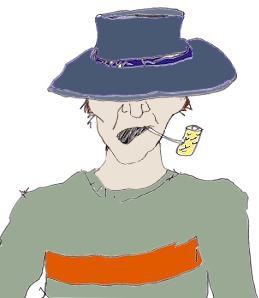 |
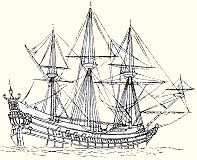
Recent email:
Subject: The Morning Sun
The morning sun twinkles through the pines and crystal clear
mountain air, its rays sparkling off the mirrored image of
the lake before me. All around the stillness of nature
nurtures the chirping and chortling of songbirds busy going
about their serene, pastoral lives in the solitude of the
pristine surroundings.
I finish my herbal tea and stroll down to the water's
edge, fully engaged in the rhythms of nature and the quiet
energy of a new day. Looking across the expanse of the nearly
transparent blue lake, my mind races to embrace it's
tranquil beauty...
"GOD! I wish I had a speedboat!"
-- Dan Crummett
Stillwater, Oklahoma
Subject: Thrilled
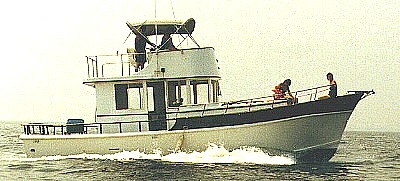 I was
thrilled to find the boat my father built back in the late
70's as the picture on your web site for the 36' Odyssea. He loved that boat more than
life, which ended in October 1988. We sold the boat to a
marina in Hampton Bays, New York, and from there who
knows?
I was
thrilled to find the boat my father built back in the late
70's as the picture on your web site for the 36' Odyssea. He loved that boat more than
life, which ended in October 1988. We sold the boat to a
marina in Hampton Bays, New York, and from there who
knows?
I can tell you that our family of 5 kids enjoyed that boat
every weekend for years and we miss our father and those
enjoyable days on the boat immensely.
Hope that photo and his name, Ed Daly of Manhasset, New York
stays there for years to come.
Thanks for the memories.
-- Ted Daly
New York City, New York
Subject: Somewhat Anally Retentive
I ordered my first set of plans from you all October 27th,
1969. How do I know that? Well, being somewhat anally
retentive, I tried to keep the plans in the best shape,
including the original mailer. I built that boat, the Pee Wee, in 1971-72 school year as a
junior in wood shop. I sold it after maybe a hundred hours of
unforgettable fun.
I regret to say that I then built an inferior design from
another company and it ended up getting a "Viking
burial" over the falls in my senior year. It was crap. I
then ordered on April 21st, 1972, a set of Glen-L Can-Yak plans which I have yet to build.
Instead, I progressed to the PowerYak plans last year, and as you are
well aware, it is about half done as I do my pictorial trek
and forward the company the installments.
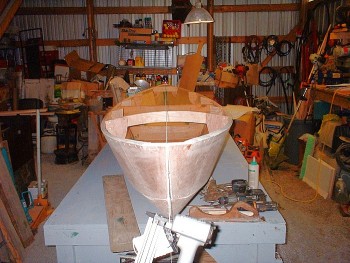 Because I am
building in an unheated shop, I have had to put my Power Yak
build on hold for a couple more months. We will see what this
summer brings.
Because I am
building in an unheated shop, I have had to put my Power Yak
build on hold for a couple more months. We will see what this
summer brings.
I envy you guys and your legacy. I will do my best to
support and honor that heritage. I am really satisfied each
time I cut-loose with the bucks for a design from you. It is
the next best thing to having all my 6 kids around me and
having a family party (that lasts a day; building lasts for
months). I guess heaven would be having them together in a
boatbuilding company. Oh, but that is what you guys are all
about, huh!
If I get my way later this building summer, I will start on
the metal version of the Goliath. I have a couple of cool
customizing ideas that I have talked to Glen about. I think
that will be a fantastic build (motors, batteries, derrick,
boom, and winches - Mini work trawler here I come). But we
will see...
Thanks again for a fantastic company, support, and
products.
-- Dan Hennis
Cassville, Missouri
Do You Need Attention, Baby?
Which boat owner do you suppose is looking for
"special" attention...
The "Love Love" was built to look as if it
is sinking. Designed by French artist Julien
Berthier, the 21-foot yacht was cut in half with a
new keel and motor added so it remains in the
sinking position while being fully functional. |
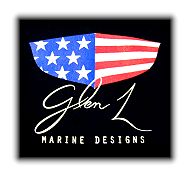
GLEN-L boats, of course

